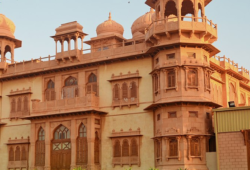Altit Fort
 Posted On
Posted On
In our beautiful Pakistan lies the birthplace of Hunza Kingdom for tourism.
Altit Fort (also known as Khabasi Residence) is an architectural marvel that has stood tall for over 1000 years in the face of many enemy attacks and natural calamities.
It is one of the best tourist attractions in Hunza Valley, located in Altit town of Hunza district.
It was the home of the then rulers of Hunza who were known as Mirs of Hunza.
The Shikari tower (portion of the fort) of the fort is the oldest monument of Gilgit Baltistan valley which is 1100 years old.
The word Altit has its roots in Tibetan and means “side down”.
Built by the Mirs of Hunza, Altit Fort functioned as a grand display of power for the Mirs of Nagar – a neighboring state – and has stood elegantly ever since.
His famous Shikari Tower was built at a strategic location that helps in monitoring the entire region and gives the army a winning edge.
Standing at the top of the tower, the strategic importance of such a high altitude is evident from the visibility of all the surrounding mountains and forests in the event of an attack.
It is said that the tower was not only used to watch for enemy attacks. but also to discard prisoners who were condemned to death.
About 400 years after its construction, Altit Fort was caught up in a family feud between two Royals, Prince Shah Abbas (Shabos) and Prince Ali Khan.
This dispute gave rise to another fort known as Baltit Fort, which was captured by the elder brother Prince Shabos, while Altit remained under the control of Prince Ali Khan.
The two fought each other and launched regular attacks, but eventually Baltit became the capital of Hunza. .
Prince Shabos
There is a legend among the locals that Prince Ali Khan’s younger brother was buried alive by Prince Shabos inside one of the pillars of the watchtower.
In 1891, the British occupied Altit, but it remained an independent princely state ruled by the Mirs, as was the custom of British occupation.
Suspecting Russian involvement in the region, the British stationed their military there.
The fort also served as the city’s commercial center with merchants from all over the world bringing their goods traveling along the famous Silk Road.
After the Indo-Pak partition, it became part of Pakistan, but remained a princely state until 1972.
When the royal status of Hunza and Nagar was dissolved by the Government of Pakistan.
Altit Fort became a popular tourist destination after its restoration by the Aga Khan Foundation in 1990.
It serves as a museum and provides a significant insight into the journey of the Mirs and Royals who inhabited the fort.
It is located 18-20 minutes’ drive (5.8 km) from the Hunza Valley and is accessible via Madal Gan and Sultan Abad Road.
Sultanabad Road
Alternatively, you can reach it directly via Karakoram Highway and Sultanabad Road. The distance from Hunza is 5.1 kilometers if you take KKH.
The fort itself is the highlight of the village of Altit in Hunza and offers visitors a museum that shows traces of ancient life including utensils used by Royals and the craftsmanship of skilled workers.
It is said that the artisans were a special gift to Mir of Hunza as part of his dowry because he married a Baltic princess.
The main attraction of the fort is the Shikari Tower, which provides a mesmerizing view of the surroundings from a height of more than 1,000 feet from the ground.
The people of Altitu have remarkable features and claim to be descendants of Greek soldiers in Alexander the Great’s army.
gHowever, the people of the old city of Altit are said to be descendants of the Turkic Hun tribe.
They came from the Persian Empire and that is why the city was called Hunukushal (village of the Huns) in ancient times.
The locals are humble and down-to-earth people who warmly welcome visitors.
English and Urdu are widely spoken and understood in the region, making communication easier for tourists from Pakistan and beyond.
In the center of Hunza, the thousand-year-old Altit forts and the 700-year-old Baltit forts are among the oldest in the region.
Standing monuments and documents of the feudal regime of the valley. Altit Fort, traditionally the home of the Mir, or King of Hunza, was eventually vacated in favor of Baltit Fort.
The rectangular fortress is located at the foot of the Ulter Glacier and overlooks the Hunza Valley and its tributaries.
A strategic position to control the trans-Karakoram trade route between South and Central Asia. The fortress served as a home for Mir until 1945.
Sources: GuidetoPakistan | Nationalgeographic


